
NCERT Solutions For Class 7 Social Science Geography Chapter 3 Our Changing Earth. We also provide Notes and Lesson Plan. Our Study Rankers specially made them for better understanding. Students may read the NCERT Social Science Geography Chapter 3 PDF to practice concepts with NCERT Solutions and Extra Questions and Answers. We prepared these by keeping in mind the latest CBSE curriculum. Shine among your friends after scoring high in Quiz, MCQ, and Worksheet
Read more: NCERT Solutions for Class 7 Social Science Geography Chapter 6: Natural Vegetation and Wildlife
Notes For NCERT Solutions For Class 7 Social Science Geography Chapter 3 Our Changing Earth
(Also find NCERT Solutions For Class 7 Social Science Geography Chapter 3 Our Changing Earth given below)
- Earth’s lithosphere is broken into a number of plates known as the Lithospheric plates.
- Lithospheric plates: The earth’s crust consists of several large and some small,rigid, irregularly-shaped plates (slabs) which carry continents and the ocean floor.
- These plates move around very slowly, just a few millimetres each year. These plates move because of the movement of the molten magma inside the earth.
- The molten magma inside the earth moves in a circular manner.
- Have you revised History Chapter 5?
Forces Causing Movement of The Earth
- The movement of these plates causes changes on the surface of the earth.
- On the basis of the forces which cause them, the earth movements are divided.
- These forces are:
1. ENDOGENIC =
Endo (Inside) + Genic (Origin)
2. EXOGENIC =
EXO (Outside) + Genic (Origin)
| ENDOGENIC FORCES | EXOGENIC FORCES |
| The forces which act in the interior of the earth are called as Endogenic forces | The forces that work on the surface of the earth are called as Exogenic forces. |
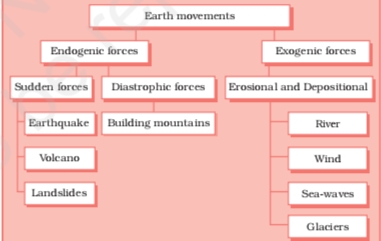
NCERT Social Science Geography Chapter 3 Fig. 3.1
Endogenic Forces
- Endogenic forces sometimes produce sudden movements and at the other times produce slow movements.
- Sudden movements like earthquakes and volcanoes cause mass destruction over the surface of the earth.
Volcano
A volcano is a vent (opening) in the earth’s crust through which molten material erupts suddenly.
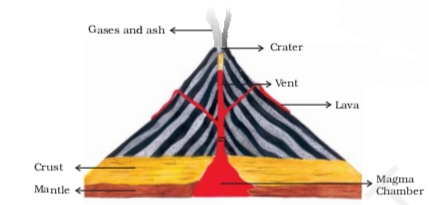
NCERT Social Science Geography Chapter 3 Fig. 3.2
Earthquake
- When the Lithospheric plates move, the surface of the earth vibrates.
- The vibrations can travel all round the earth. These vibrations are what we call earthquakes.
- The focus is the place in the crust where the movement starts.
- The epicentre is the place on the surface above the focus.
- Vibrations travel outwards from the epicentre as waves.
- There are three types of earthquake waves:
- P waves or longitudinal waves
- S waves or transverse waves
- L waves or surface waves
- Greatest damage is usually closest to the epicentre and the strength of the earthquake decreases away from the centre.
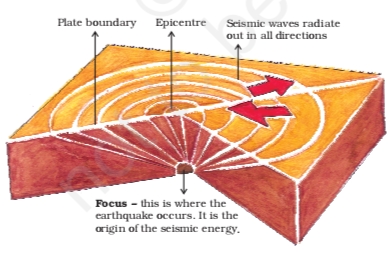
NCERT Social Science Geography Chapter 3 Fig. 3.3
Seismograph
- A machine, seismograph measures earthquake.
- The magnitude of the earthquake is measured on the Richter scale.
- An earthquake of 2.0 or less: you can feel it only a little.
- An earthquake over 5.0: It can cause damage from things falling.
- A 6.0 or higher magnitude: It is very strong.
- A 7.0: It is as a major earthquake.

Earthquake Preparedness
Some common earthquake prediction methods adopted locally by people include studying animal behaviour; earthquakes agitate the fish in the ponds, snakes come to the surface.
- Safe Spot – Under a kitchen counter, table or desk, against an inside corner or wall.
- Stay Away from – Fire places, areas around chimneys, windows that shatter including mirrors and picture frames.
- Be Prepared – Spread awareness amongst your friends and family members and face any disaster confidently.
Major Land Forms (Exogenic Forces)
- Two processes – weathering and erosion (Exogenic Forces) – constantly wear away the landscape.
- Weathering is the breaking up of the rocks on the earth’s surface.
- Erosion is the wearing away of the landscape by different agents like water, wind and ice.
- Water, wind, etc. carries, transports and eventually deposits the eroded material.
- This process of erosion and deposition create different landforms on the surface of the earth.
Work Of A River
- The running water in the river erodes the landscape.
- When the river tumbles at steep angle over very hard rocks or down a steep valley side it forms a waterfall.
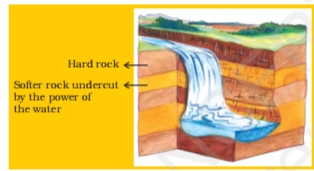
NCERT Social Science Geography Chapter 3 Fig. 3.4
- As the river enters the plain it twists and turns forming large bends known as meanders.
- Due to continuous erosion and deposition along the sides of the meander, the ends of the meander loop come closer and closer.
- In due course of time the meander loop cuts off from the river and forms a cut-off lake, also called an ox-bow lake.
- At times the river overflows its banks. This leads to the flooding of the neighbouring areas.
- As it floods, it deposits layers of fine soil and other material called sediments along its banks. This leads to the formation of a flat fertile floodplain.
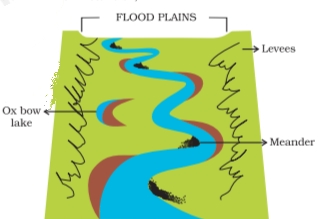
NCERT Social Science Geography Chapter 3 Fig. 3.5
- Levees are the raised banks.
- As the river approaches the sea, the speed of the flowing water decreases and the river begins to break up into a number of streams called distributaries.
- The river becomes so slow that it begins to deposit its load.
- Each distributary forms its own mouth.
- The collection of sediments from all the mouths forms a delta.
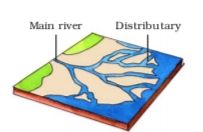
NCERT Social Science Geography Chapter 3 Fig. 3.6
Work of Sea Waves
- The erosion and deposition of the sea waves gives rise to coastal landforms.
- Sea waves continuously strike at the rocks. Cracks develop. Over time they become larger and wider.
- Thus, hollow like caves are formed on the rocks – sea caves.
- As these cavities become bigger and bigger only the roof of the caves remain, thus forming sea arches.
- Further, erosion breaks the roof, leaving only walls. Stacks is the name for these wall like features.
- Sea cliff is the steep rocky coast rising almost vertically above sea water.
- The sea waves deposit sediments along the shores forming beaches.
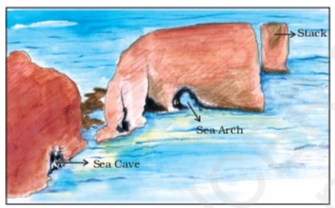
NCERT Social Science Geography Chapter 3 Fig. 3.7
Work Of Ice
- Glaciers are “rivers” of ice which too erode the landscape by bulldozing soil and stones to expose the solid rock below.
- Glaciers carve out deep hollows. As the ice melts, glaciers fill up with water and become beautiful lakes in the mountains.
- The glacier carries and deposits the material such as rocks big and small, sand and silt.
- These deposits form glacial moraines.
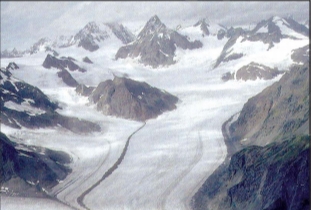
NCERT Social Science Geography Chapter 3 Fig. 3.8
Work Of Wind
- An active agent of erosion and deposition in the deserts is wind.
- In deserts you can see rocks in the shape of a mushroom, commonly called mushroom rocks.
- Winds erode the lower section of the rock more than the upper part. Therefore, such rocks have narrower base and wider top.
- When the wind blows, it lifts and transports sand from one place to another.
- And when it stops blowing the sand falls and gets deposited in low hill – like structures.These are called sand dunes.
- When the grains of sand are very fine and light, the wind can carry it over very long distances.
- When such sand is deposited in large areas, it is called loess. Large deposits of loess is found in China.
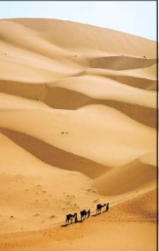
NCERT Social Science Geography Chapter 3 Fig. 3.9
NCERT Solutions For Class 7 Social Science Geography Chapter 3 Our Changing Earth
(Also find NCERT Solutions For Class 7 Social Science Geography Chapter 3 Our Changing Earth given below)
Q. 1. Answer the following questions briefly:
- Why do the plates move?
- What are exogenic and endogenic forces?
- What is erosion?
- How are flood plains formed?
- What are sand dunes?
- How are the beaches formed?
- What are the ox-bow lakes?
A)
- The lithospheric plates move because of the movement of the molten magma inside the earth.The molten magma inside the earth moves in a circular manner.
- Exogenic Forces – The forces that work on the surface of the earth are called as Exogenic forces. Eg, Weathering, Gradation, Erosion, Deposition.
- Endogenic Forces – The forces which act in the interior of the earth are called as Endogenic forces. Eg, Volcanoes and Earthquakes.
- Erosion is the wearing away of the landscape by different agents like water, wind and ice. Water, wind, etc. carries, transports and eventually deposits the eroded material. This process of erosion and deposition create different landforms on the surface of the earth.
- At times the river overflows its banks. This leads to the flooding of the neighbouring areas. As it floods, it deposits layers of fine soil and other material called sediments along its banks. This leads to the formation of a flat fertile floodplain.
- When the wind blows, it lifts and transports sand from one place to another and when it stops blowing the sand falls and gets deposited in low hill – like structures.These are called sand dunes.
- The sea waves deposit sediments along the shores forming beaches.
- Due to continuous erosion and deposition along the sides of the meander, the ends of the meander loop come closer and closer. In due course of time the meander loop cuts off from the river and forms a cut-off lake, also called an ox-bow lake.
Q. 2. Tick the correct answer:
- Which is not an erosional feature of sea waves?
- Cliff
- Beach
- Sea cave.
A) 1. Cliff
- The depositional feature of a glacier is
- Flood plain
- Beach
- Moraine.
A) 3. Moraine
- Which is caused by the sudden movements of the Earth ?
- Volcano
- Folding
- Flood plain.
A) 1. Volcano
- Mushroom rocks are found In
- Deserts
- River valleys
- Glaciers.
A) 1. Deserts
- Ox bow lakes are found In
- Glaciers
- River valleys
- Deserts.
A) 2. River Valleys
Q. 3. Match the Following
| Column I | Column II |
| Glacier | Sea Shore |
| Meanders | Mushroom Rock |
| Beach | River of Ice |
| Sand Dunes | Rivers |
| Waterfall | Vibrations of Earth |
| Earthquake | Sea Cliffs |
| Hard Bed Rock | |
| Deserts |
A)
| Column I | Column II |
| Glacier | River of Ice |
| Meanders | Hard Bed Rock |
| Beach | Sea Shore |
| Sand Dunes | Deserts |
| Waterfall | Rivers |
| Earthquake | Vibrations of Earth |
Q. 4. Give reasons:
- Some rocks have the shape of a mushroom.
- Flood plains are very fertile.
- Sea caves are turned into stacks.
- Buildings collapse due to earthquakes.
A)
- In deserts you can see rocks in the shape of a mushroom, commonly called mushroom rocks. Winds erode the lower section of the rock more than the upper part. Therefore, such rocks have narrower base and wider top.
- A flat floodplain has layers of fine soil and other material called sediments along its banks making it fertile.
- Hollow like caves are formed on the rocks – sea caves. These cavities become bigger and bigger only the roof of the caves remain, thus forming sea arches. Further, erosion breaks the roof, leaving only walls. Stacks is the name for these wall like features.
- Many buildings are not earthquake-proof. The buildings are not capable of resisting the vibrations of the earthquakes and hence they fall down.
Some Frequently Asked Questions
(Here you can find the NCERT Solutions For Class 7 Social Science Geography Chapter 3 Our Changing Earth FAQs.)
Q. 1. What are the effects of winds?
A)
- Winds erode the lower section of the rock more than the upper part. Therefore, such rocks have narrower base and wider top.
- When the wind blows, it lifts and transports sand from one place to another. And when it stops blowing the sand falls and gets deposited in low hill – like structures.These are called sand dunes.
- When the grains of sand are very fine and light, the wind can carry it over very long distances. When such sand is deposited in large areas, it is called loess.
Q. 2. Explain the work of ice.
A) Some works of ice are:
- Glaciers are “rivers” of ice which too erode the landscape by bulldozing soil and stones to expose the solid rock below.
- Glaciers carve out deep hollows. As the ice melts, glaciers fill up with water and become beautiful lakes in the mountains.
- The glacier carries and deposits the material such as rocks big and small, sand and silt.These deposits form glacial moraines.
Conclusion: NCERT Solutions For Class 7 Social Science Geography Chapter 3 Our Changing Earth
Above written includes NCERT Solutions For Class 7 Social Science Geography Chapter 3 Our Changing Earth, detailed Explanation, and Question Answers. Browse our site for various detailed and easy NCERT Solutions and CBSE Notes.